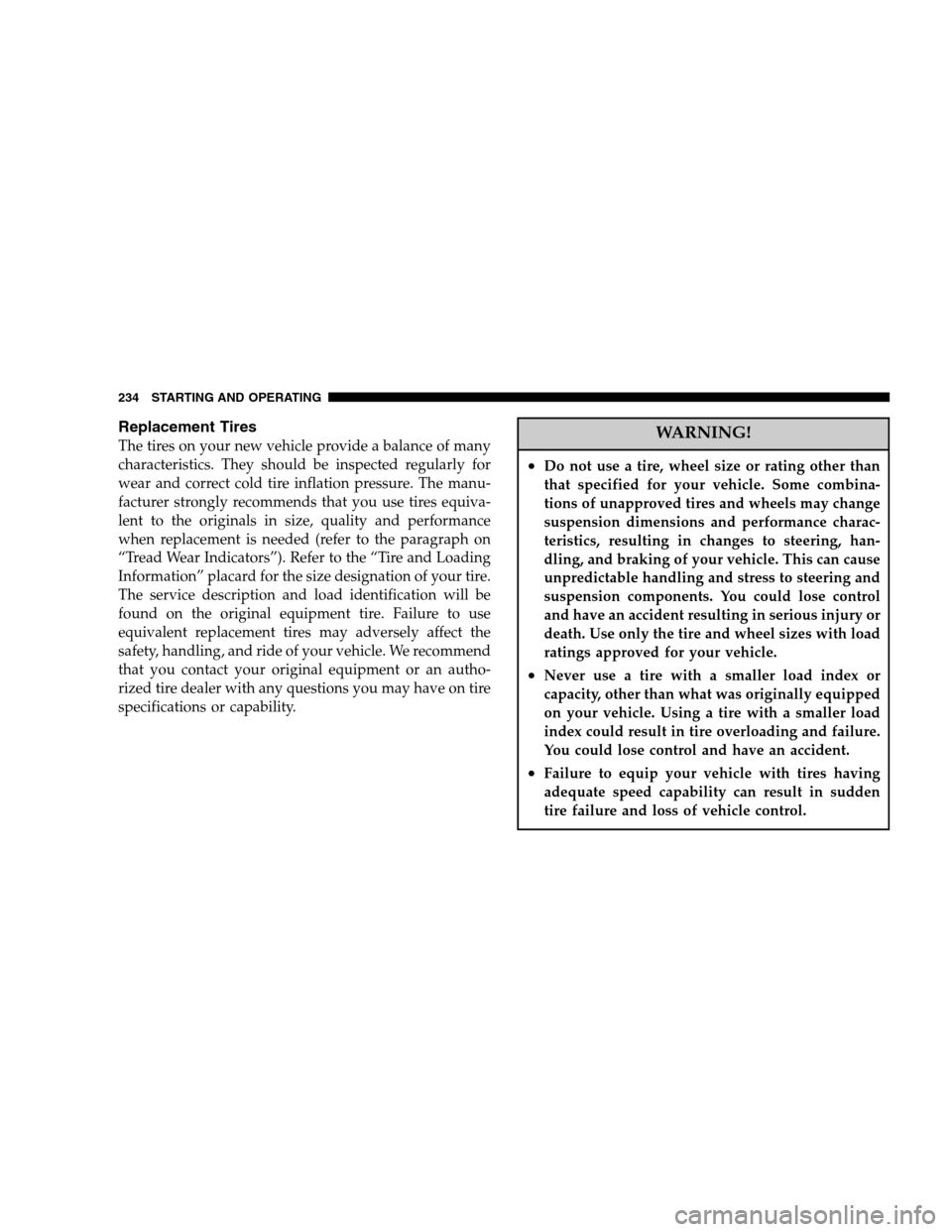2007 CHRYSLER 300 SRT inflation pressure
[x] Cancel search: inflation pressurePage 231 of 360

CAUTION!
After inspecting or adjusting the tire pressure, al-
ways reinstall the valve stem cap (if equipped). This
will prevent moisture and dirt from entering the
valve stem, which could damage the valve stem.
Inflation pressures specified on the placard are always
“cold tire inflation pressure.” Cold tire inflation pressure
is defined as the tire pressure after the vehicle has not
been driven for at least 3 hours, or driven less than 1 mile
(1 km) after a 3 hour period. The cold tire inflation
pressure must not exceed the maximum inflation pres-
sure molded into the tire sidewall.
Check tire pressures more often if subject to a wide range
of outdoor temperatures, as tire pressures vary with
temperature changes.
Tire pressures change by approximately 1 psi (7 kPa) per
12° F (7° C) of air temperature change. Keep this in mind
when checking tire pressure inside a garage, especially in
the winter.Example: If garage temperature = 68° F (20° C) and the
outside temperature = 32° F (0° C) then the cold tire
inflation pressure should be increased by 3 psi (21 kPa),
which equals 1 psi (7 kPa) for every 12° F (7° C) for this
outside temperature condition.
Tire pressure may increase from 2 to 6 psi (13 to 40 kPa)
during operation. DO NOT reduce this normal pressure
build up or your tire pressure will be too low.
Tire Pressures for High Speed Operation
The manufacturer advocates driving at safe speeds
within posted speed limits. Where speed limits or condi-
tions are such that the vehicle can be driven at high
speeds, maintaining correct tire inflation pressure is very
important. Increased tire pressure and reduced vehicle
loading may be required for high-speed vehicle opera-
tion. Refer to original equipment or an authorized tire
dealer for recommended safe operating speeds, loading
and cold tire inflation pressures.
STARTING AND OPERATING 231
5
Page 234 of 360

Replacement Tires
The tires on your new vehicle provide a balance of many
characteristics. They should be inspected regularly for
wear and correct cold tire inflation pressure. The manu-
facturer strongly recommends that you use tires equiva-
lent to the originals in size, quality and performance
when replacement is needed (refer to the paragraph on
“Tread Wear Indicators”). Refer to the “Tire and Loading
Information” placard for the size designation of your tire.
The service description and load identification will be
found on the original equipment tire. Failure to use
equivalent replacement tires may adversely affect the
safety, handling, and ride of your vehicle. We recommend
that you contact your original equipment or an autho-
rized tire dealer with any questions you may have on tire
specifications or capability.WARNING!
•Do not use a tire, wheel size or rating other than
that specified for your vehicle. Some combina-
tions of unapproved tires and wheels may change
suspension dimensions and performance charac-
teristics, resulting in changes to steering, han-
dling, and braking of your vehicle. This can cause
unpredictable handling and stress to steering and
suspension components. You could lose control
and have an accident resulting in serious injury or
death. Use only the tire and wheel sizes with load
ratings approved for your vehicle.
•Never use a tire with a smaller load index or
capacity, other than what was originally equipped
on your vehicle. Using a tire with a smaller load
index could result in tire overloading and failure.
You could lose control and have an accident.
•Failure to equip your vehicle with tires having
adequate speed capability can result in sudden
tire failure and loss of vehicle control.
234 STARTING AND OPERATING
Page 239 of 360

TIRE PRESSURE MONITOR SYSTEM (TPMS) — IF
EQUIPPED
•
The Tire Pressure Monitor System (TPMS) will warn
the driver of a low tire pressure based on the vehicle
recommended cold placard pressure.
•The tire pressure will vary with temperature by about
1 psi (6.9 kPa) for every 12°F (6.5°C). This means that
when the outside temperature decreases, the tire pres-
sure will decrease. Tire pressure should always be set
based on cold inflation tire pressure. This is defined as
the tire pressure after the vehicle has not been driven
for at least 3 hours, or driven less than 1 mile (1 km)
after a 3 hour period. The cold tire inflation pressure
must not exceed the maximum inflation pressure
molded into the tire sidewall. Refer to the “Tires –
General Information” in this section for information
on how to properly inflate the vehicle’s tires. The tire
pressure will also increase as the vehicle is driven - this
is normal and there should be no adjustment for this
increased pressure.
•The TPM System will warn the driver of a low tire
pressure if the tire pressure falls below the low-
pressure warning limit for any reason, including low
temperature effects.
•The TPM System will continue to warn the driver of
low tire pressure as long as the condition exists, and
will not turn off until the tire pressure is at or above
the recommended cold placard pressure. Once the low
tire pressure warning (Tire Pressure Monitoring Tell-
tale Light) illuminates, you must increase the tire
pressure to the recommended cold placard pressure in
order for the Tire Pressure Monitoring Telltale Light to
turn off. The system will automatically update and the
Tire Pressure Monitoring Telltale Light will turn off
once the system receives the updated tire pressures.
The vehicle may need to be driven for up to 10 minutes
above 15 mph (25 km/h) in order for the TPMS to
receive this information.
STARTING AND OPERATING 239
5
Page 241 of 360

NOTE:
•
The TPMS is not intended to replace normal tire care
and maintenance, or to provide warning of a tire
failure or condition.
•The TPMS should not be used as a tire pressure gauge
while adjusting your tire pressure.
•Driving on a significantly under-inflated tire causes
the tire to overheat and can lead to tire failure.
Under-inflation also reduces fuel efficiency and tire
tread life, and may affect the vehicle’s handling and
stopping ability.
•The TPMS is not a substitute for proper tire mainte-
nance, and it is the driver ’s responsibility to maintain
correct tire pressure, even if under-inflation has not
reached the level to trigger illumination of the Tire
Pressure Monitoring Telltale light.
Base System — If Equipped
The Tire Pressure Monitor System (TPMS) uses wireless
technology with wheel rim mounted electronic sensors tomonitor tire pressure levels. Sensors, mounted to each
wheel as part of the valve stem, transmit tire pressure
readings to the Receiver Module.
NOTE:It is particularly important for you to check the
tire pressure in all of the tires on your vehicle regularly
and to maintain the proper pressure.
The TPMS consists of the following components:
•Receiver Module
•4 Tire Pressure Monitoring Sensors
•Tire Pressure Monitoring Telltale Light
Tire Pressure Monitoring Low Pressure Warnings
The Tire Pressure Monitoring Telltale Light will
illuminate in the instrument cluster and an audible
chime will sound when tire pressure is low in one
or more of the four active road tires. The audible chime
will sound once every ignition cycle for each condition
that it detects. Should this occur, you should stop as soon
as possible, check the inflation pressure of each tire on
your vehicle, and inflate each tire to the vehicle’s recom-
mended cold placard pressure value. Once the system
STARTING AND OPERATING 241
5
Page 352 of 360

Infant Restraint....................... 47,48
Inflation Pressure Tires................... 141
Information Center, Vehicle............... 144
Instrument Cluster...................135,136
Instrument Panel and Controls............. 134
Instrument Panel Lens Cleaning............ 299
Interior Appearance Care................. 298
Interior Fuses.......................... 300
InteriorLights ......................... 100
Intermittent Wipers (Delay Wipers)......... 101
Introduction............................ 4
Jump Starting......................... 262
Key, Programming....................... 14
Key, Replacement....................... 13
Key, Sentry (Immobilizer).................. 12
Key-In Reminder........................ 12
Keyless Entry System..................... 17
Keys................................. 11
Knee Bolster........................... 38
Lane Change and Turn Signals.............. 98Lap/Shoulder Belts...................... 30
LATCH
(Lower Anchors and Tether for CHildren) . . . 50,52
LatchPlate ............................ 31
Latches............................... 58
Hood............................... 93
Lead Free Gasoline...................... 246
LifeofTires ........................... 233
Lights .............................. 58,95
Airbag ....................... 43,46,58,137
Anti-Lock........................137,213
Automatic Headlights................... 95
Brake Assist Warning.................. 219
BrakeWarning ....................138,211
Bulb Replacement..................... 307
Courtesy/Reading.................. 99,115
Cruise ............................. 136
Daytime Running...................... 98
Dimmer Switch, Headlight............. 98,99
Electronic Stability Program
(ESP) Indicator......................... 219
Electronic Throttle Control Warning....... 141
Engine Temperature Warning............ 137
352 INDEX
Page 358 of 360

Tachometer........................... 137
Telescoping Steering Column.............. 107
Temperature Control, Automatic (ATC)....... 183
Temperature Gauge, Engine Coolant......139,257
Tether Anchor, Child Restraint.............. 50
Theft Alarm (Security Alarm)............... 15
Theft System (Security Alarm).............. 15
Tilt Steering Column.................... 107
Tire and Loading Information Placard....... 225
Tire Identification Number (TIN)........... 224
Tire Markings......................... 220
Tire Safety Information................... 220
TIREFIT.............................. 257
Tires ........................... 58,229,343
Aging(LifeofTires) ................... 233
Air Pressure......................... 229
Alignment.......................... 235
Chains............................. 235
General Information................... 229
High Speed......................... 231
Inflation Pressures.................... 230
LifeofTires ......................... 233
Load Capacity....................225,226Pressure Monitor System (TPMS)......... 239
Quality Grading...................... 343
Radial............................. 232
Replacement......................... 234
Rotation ............................ 237
Safety ...........................220,229
Sizes ............................... 222
Snow Tires.......................... 236
Spinning ............................ 232
TreadWearIndicators .................. 233
Towing .............................. 254
Behind a Motor Home................. 254
Disabled Vehicle...................... 266
Recreational......................... 254
Trailering ........................... 254
Towing Vehicle Behind a Motor Home....... 254
Traction Control........................ 215
TrailerTowing ......................... 254
Transmission.......................... 294
Automatic ........................203,294
Fluid .............................. 315
Shifting............................ 199
358 INDEX